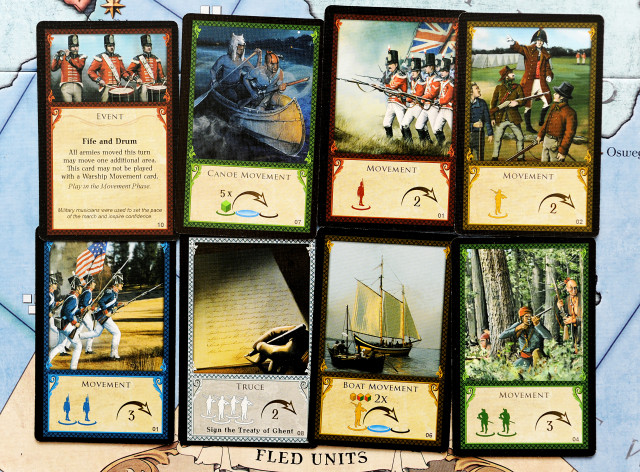Educational games have a bad reputation. We were force fed that type of game as kids and so often the experience fell short of the experience that we considered pure entertainment. The burden of trying to impart information on history, geography, math or any other subject didn’t always merge seamlessly with cool mechanics or a dynamic experience. Times have changed and many games now approach the idea of learning with a lot more savvy. The mechanics often come first and the lesson is something that is digested long after playing. There have always been titles set in historic times, but the history involved was often lost in the game play. That is slowly beginning to change. Games like Timeline, Fauna, Rory’s Story Cubes and A Few Acres of Snow, for example have taken the idea of an educational game and made them fun.
Academy Games is taking that concept a step further. With its series of games like 1812, 1776 and Freedom: The Underground Railroad, Academy is designing not just for the tabletop, but the classroom as well. Each of its games strives for historical and political accuracy and include enough supplementary information to supply a high school history class.
Released in 2012, on the 200 year anniversary of the war, 1812: The Invasion of Canada offers not only a lesson in U.S. Canadian history, but also a fantastic intro into war games for those interested in the genre, but intimidated with heavier fare.
Designed by Beau Beckett and Jeph Stahl, 1812 pits the British Regulars, Canadian Militia and Native Americans against the invading American Regulars and American Militia. Two to five players join the battle on either side. Actions are played out through cards and battles are fought with custom dice for each faction. 
The map shows parts of Upper and Lower Canada and sates like Michigan, New York, New Hampshire and Ohio. Each of the different factions start with a number of their coloured armies (represented by cubes) on the board. 1812 lasts for up to eight rounds, but the win condition is checked starting at the end of the third round. Game end is triggered when all the factions on one or both sides have played their Truce cards. The winning team (deciding whether history repeats itself or not) is the one with the most Control Flags on the board. Flags are placed when one side captures a strategic territory on their opponent’s side of the border.
Each round the turn order is determined randomly. Markers for each faction are placed in a draw bag and one at a time taken out. The active player completes their entire turn before the next faction is drawn, which can lead to some tense decision making. Who plays when can be very important.
Turns are divided into phases. The enlistment phase allows players to add units onto the board in their specific muster areas. During the movement phase players must play a card from their hand. This indicates how many troops can move a certain distance and whether they move over land or water. When moving troops there must be at least one unit from the active faction, but it’s also possible to move other allied units. Battles occur when enemy forces occupy the same territory. The side fighting on home ground gets the initiative and rolls first. Battle dice are unique to each faction and each contains some combination of Hit, Flee, and Command Decision. Hits take out enemy units. Flees force you to remove a unit to the Fled Units space on the board (don’t worry, those yellow-bellies will be thrown back into battle the next time you muster units). The Command Decision gives you the choice to remove units to adjacent safe territories. 
There are a lot of territories to win or lose during the game, but really you’re looking to take control of your opponents forts. They are indicated on the board by a star and represent historically important locations in 1812. Taking one of those spaces allows you to place a Control Flag and, as stated, that is how you win the game. Your team can rush the game end by playing out Truce cards if you have more Control Flags on the board, but that random turn order can really make for a tough decision.
1812 is a great introduction to war games. It looks a bit complicated, but it really isn’t. If you are looking for a game that is the next step up from a RISK, this is worth checking out. I think it shines with the full compliment of five players, but even at two it works really well. I’m looking forward to seeing what historical moments Academy Games will tackle next.
Nice to see games of this sort and so well done. Thank you for the review.